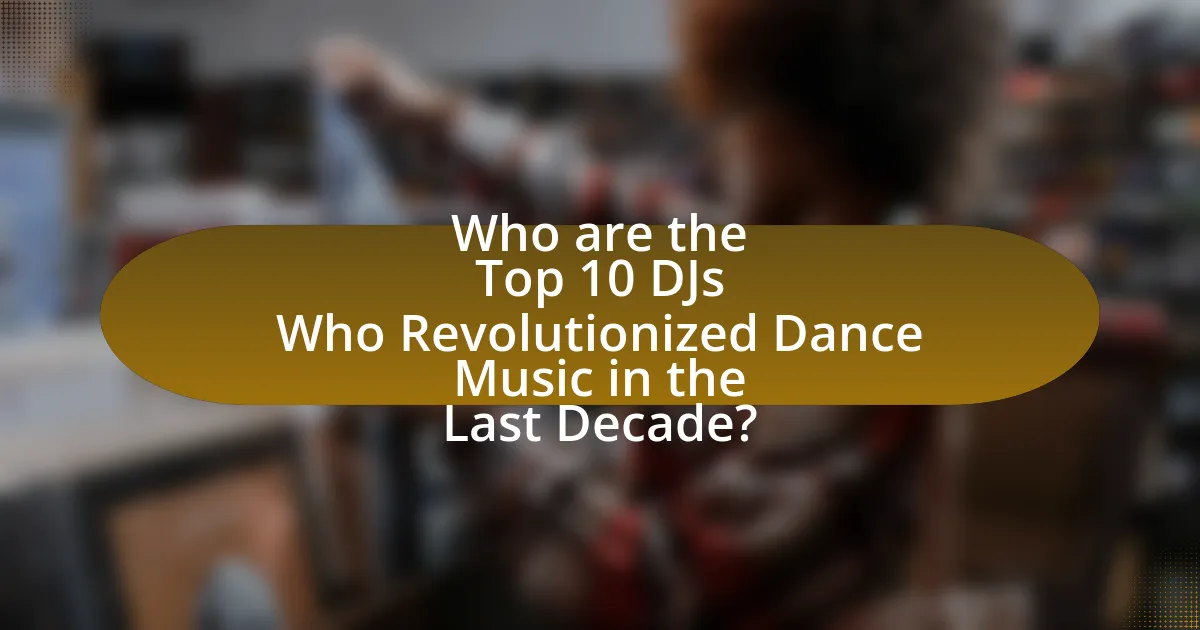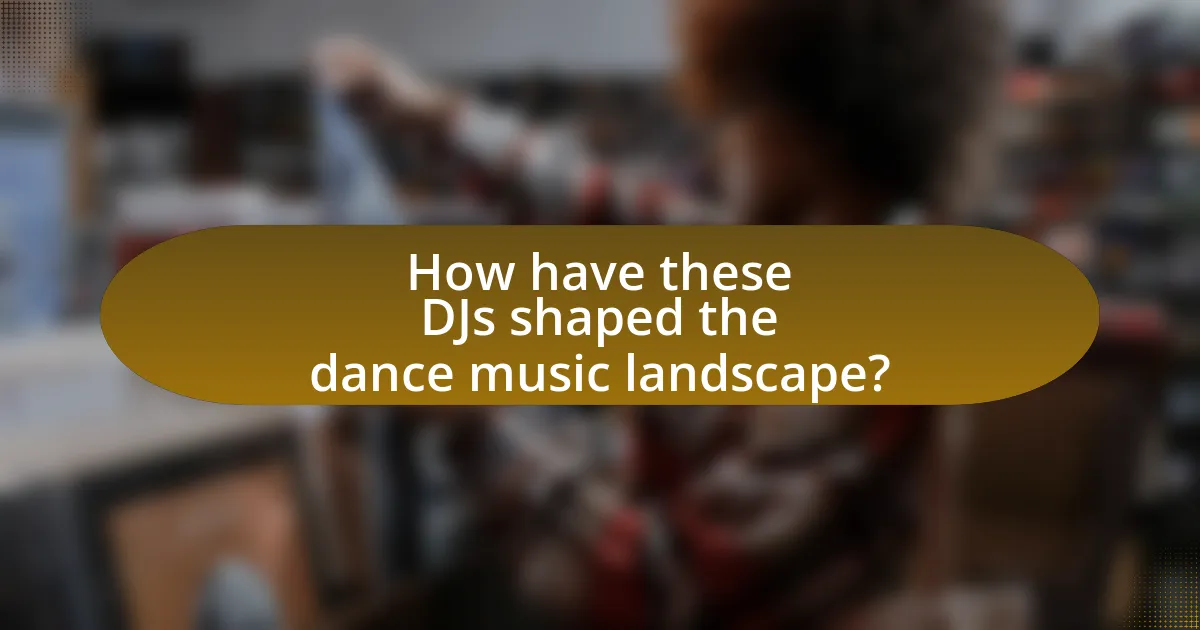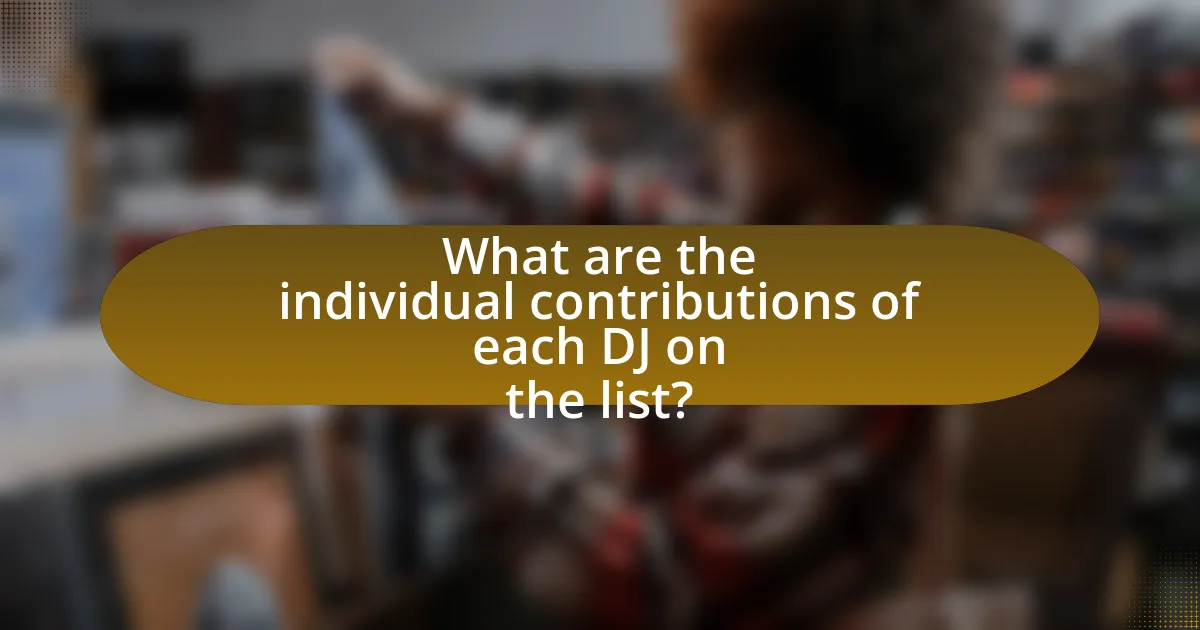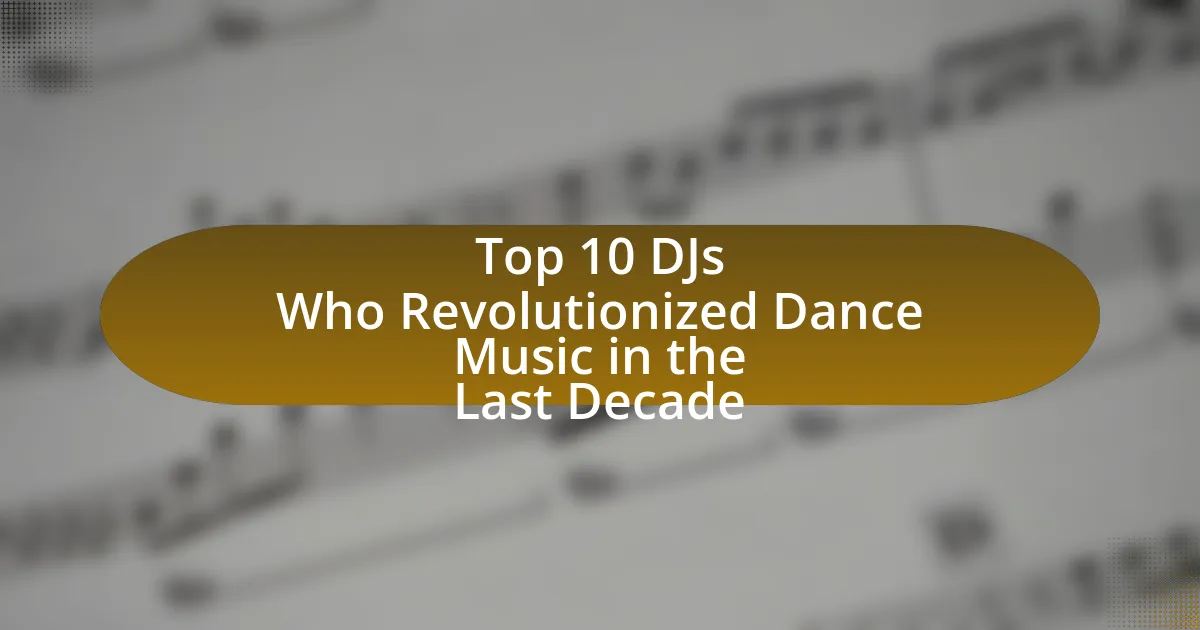The article focuses on the top 10 DJs who have revolutionized dance music over the last decade, highlighting influential figures such as Calvin Harris, David Guetta, Skrillex, and Tiësto. It examines the criteria that define a DJ’s revolutionary impact, including innovation in sound, cultural influence, and industry shaping. The piece also discusses the evolution of electronic dance music (EDM), the significance of sub-genres, and the unique techniques employed by these DJs in their mixing and production. Additionally, it addresses the metrics used to measure success, notable collaborations, and the mentorship roles these DJs play in inspiring the next generation of artists.

Who are the Top 10 DJs Who Revolutionized Dance Music in the Last Decade?
The top 10 DJs who revolutionized dance music in the last decade are Calvin Harris, David Guetta, Skrillex, Tiësto, Deadmau5, Marshmello, Diplo, Armin van Buuren, Zedd, and Fisher. These DJs have significantly influenced the genre through innovative production techniques, genre-blending styles, and massive festival performances. For instance, Calvin Harris has consistently topped charts with his fusion of pop and electronic music, while Skrillex’s dubstep sound has reshaped the landscape of electronic dance music. Their contributions have not only garnered numerous awards but have also expanded the global reach and popularity of dance music, making it a dominant force in the music industry.
What criteria define a DJ’s revolutionary impact on dance music?
A DJ’s revolutionary impact on dance music is defined by their innovation in sound, influence on culture, and ability to shape the music industry. Innovation in sound includes the introduction of new genres, techniques, or technology that transforms the listening experience, such as the use of live remixing or unique sampling methods. Influence on culture is demonstrated through the ability to create movements or trends that resonate with audiences, often leading to significant shifts in social dynamics within the dance music scene. Additionally, shaping the music industry involves altering how music is produced, distributed, and consumed, which can be evidenced by a DJ’s role in popularizing streaming platforms or changing the dynamics of live performances. For instance, the rise of DJs like Calvin Harris and Skrillex has not only introduced new sounds but also redefined the commercial landscape of electronic music, leading to increased festival attendance and mainstream acceptance.
How do innovation and creativity play a role in a DJ’s influence?
Innovation and creativity significantly enhance a DJ’s influence by enabling them to develop unique sounds and experiences that resonate with audiences. For instance, DJs like Skrillex have transformed electronic music by incorporating elements from various genres, such as dubstep and pop, which has broadened their appeal and established new trends in the industry. This innovative approach not only attracts a diverse fan base but also inspires other artists to experiment, thereby shaping the overall landscape of dance music. Furthermore, creative use of technology, such as live remixing and interactive performances, allows DJs to engage audiences in novel ways, reinforcing their impact and relevance in the music scene.
What metrics are used to measure a DJ’s success and impact?
Metrics used to measure a DJ’s success and impact include ticket sales, social media following, streaming numbers, and chart rankings. Ticket sales reflect a DJ’s popularity and demand, while social media following indicates their reach and engagement with fans. Streaming numbers on platforms like Spotify or Apple Music demonstrate the DJ’s music consumption and popularity, and chart rankings provide a quantifiable measure of their success in the music industry. For instance, a DJ with millions of streams and high chart placements is often considered influential in shaping dance music trends.
What genres of dance music have been most influenced by these DJs?
The genres of dance music most influenced by top DJs in the last decade include EDM, house, techno, and trap. These DJs have played a pivotal role in popularizing electronic dance music (EDM), which has seen a surge in mainstream acceptance, particularly through festivals and radio play. House music has evolved with sub-genres like deep house and future house, largely due to the innovative sounds introduced by these DJs. Techno has also experienced a resurgence, with artists blending traditional elements with modern production techniques. Additionally, trap music has gained prominence, incorporating electronic elements that have been championed by DJs, further diversifying the dance music landscape.
How has electronic dance music evolved in the last decade?
Electronic dance music (EDM) has evolved significantly in the last decade, marked by diversification in sub-genres, increased mainstream acceptance, and technological advancements in production. The rise of artists like Marshmello and The Chainsmokers has brought melodic and pop-infused elements to the forefront, while festivals such as Tomorrowland and Ultra Music Festival have expanded their global reach, attracting millions of attendees. Additionally, the integration of social media platforms has allowed for greater artist-fan interaction and promotion, leading to viral hits and collaborations across genres. The use of advanced software and hardware has also transformed production techniques, enabling artists to create more complex and polished tracks.
What role do sub-genres play in the revolution of dance music?
Sub-genres play a crucial role in the revolution of dance music by fostering innovation and diversity within the genre. They allow artists to experiment with different sounds and styles, leading to the emergence of new trends and movements. For instance, the rise of sub-genres like deep house, future bass, and trap has expanded the audience for dance music, attracting listeners with varied musical tastes. This diversification has been supported by platforms such as SoundCloud and Spotify, which enable niche genres to gain traction and reach global audiences. The evolution of dance music is thus significantly shaped by these sub-genres, as they continuously redefine the landscape and influence mainstream music trends.
What are the common characteristics of the top DJs on this list?
The common characteristics of the top DJs on this list include exceptional technical skills, innovative music production, and strong audience engagement. These DJs demonstrate high proficiency in mixing and beatmatching, which allows them to create seamless transitions between tracks. Their innovative music production often incorporates unique sounds and styles, pushing the boundaries of dance music. Additionally, they excel in audience engagement through captivating performances and effective use of social media, which helps them build a loyal fan base. These traits collectively contribute to their status as influential figures in the dance music scene over the last decade.
How do these DJs engage with their audience during performances?
DJs engage with their audience during performances primarily through interactive elements such as crowd participation, visual effects, and personalized setlists. For instance, many DJs encourage audience involvement by inviting them to sing along or respond to specific cues, creating a shared experience that enhances the energy of the performance. Additionally, the use of visual effects, including light shows and video projections, captivates the audience’s attention and complements the music, making the experience more immersive. Personalized setlists, tailored to the crowd’s reactions, further demonstrate a DJ’s ability to connect with their audience, as they adapt their performance in real-time based on the energy and mood of the attendees. This dynamic interaction fosters a sense of community and engagement, which is essential in the dance music scene.
What unique techniques do they employ in their mixing and production?
Top DJs employ unique techniques in their mixing and production, such as advanced sampling, real-time remixing, and the use of AI-driven tools. For instance, many DJs utilize sampling to incorporate diverse sounds and genres, creating a rich auditory experience. Real-time remixing allows them to adapt their sets dynamically, responding to audience energy and preferences. Additionally, AI-driven tools assist in generating innovative sounds and automating certain production processes, enhancing creativity and efficiency. These techniques have been pivotal in shaping modern dance music, allowing DJs to push boundaries and engage listeners in new ways.

How have these DJs shaped the dance music landscape?
These DJs have shaped the dance music landscape by introducing innovative sounds, popularizing new genres, and influencing global music trends. For instance, artists like Calvin Harris and David Guetta have blended pop elements with electronic dance music (EDM), leading to mainstream acceptance and chart-topping hits. Additionally, DJs such as Skrillex have pioneered dubstep, significantly impacting the genre’s evolution and its integration into popular culture. Their performances at major festivals and collaborations with diverse artists have further expanded the reach of dance music, making it a dominant force in the music industry.
What innovations have these DJs introduced to the music industry?
These DJs have introduced innovations such as live remixing, advanced digital production techniques, and immersive audio-visual experiences to the music industry. For instance, DJs like Calvin Harris and David Guetta have popularized the use of electronic music in mainstream pop, blending genres and creating crossover hits that dominate charts. Additionally, the integration of technology, such as Serato and Ableton Live, has transformed traditional DJing into a more dynamic performance art, allowing for real-time manipulation of tracks. This evolution has led to the rise of festival culture, where large-scale events feature elaborate stage designs and synchronized light shows, enhancing audience engagement and creating a unique atmosphere.
How have technology and social media influenced their reach?
Technology and social media have significantly expanded the reach of DJs by enabling direct engagement with global audiences. Platforms like Instagram, TikTok, and YouTube allow DJs to share their music, performances, and personal brand instantly, reaching millions without traditional media barriers. For instance, DJ Marshmello gained fame through viral social media content, amassing over 50 million followers on Instagram, which directly contributed to his concert attendance and streaming numbers. Additionally, streaming services like Spotify and SoundCloud provide DJs with platforms to distribute their music widely, leading to increased visibility and fan interaction. This combination of social media and technology has transformed how DJs connect with fans, promoting their work and enhancing their global presence.
What collaborations have significantly impacted their careers?
Collaborations that have significantly impacted the careers of top DJs include Calvin Harris’s partnership with Rihanna on “We Found Love,” which topped charts globally and solidified Harris’s status as a leading producer. Additionally, David Guetta’s work with Sia on “Titanium” not only became a massive hit but also showcased Guetta’s ability to blend pop and electronic music, expanding his audience. Another notable collaboration is Skrillex’s work with Diplo in the duo Jack Ü, particularly on the track “Where Are Ü Now” featuring Justin Bieber, which achieved critical acclaim and commercial success, further establishing Skrillex’s influence in the electronic dance music scene. These collaborations exemplify how strategic partnerships can elevate a DJ’s career and broaden their reach in the music industry.
How have these DJs influenced upcoming artists and the next generation?
These DJs have significantly influenced upcoming artists and the next generation by setting new standards in music production, performance, and audience engagement. Their innovative techniques, such as the use of advanced technology and unique sound design, have inspired emerging artists to experiment with their own styles. For instance, DJs like Calvin Harris and Skrillex have popularized genres like EDM and dubstep, leading to a surge in new artists adopting these sounds. Additionally, their success in blending various musical genres has encouraged a more diverse range of influences in contemporary music, fostering creativity among new talent. The impact of these DJs is evident in the growing number of collaborations and remixes that reflect their signature styles, demonstrating their role as trendsetters in the industry.
What mentorship roles have these DJs taken on?
These DJs have taken on various mentorship roles, including guiding emerging artists, hosting workshops, and participating in music production camps. For instance, many have collaborated with up-and-coming DJs to share their expertise in mixing and production techniques, fostering the next generation of talent in the dance music scene. Additionally, some have established their own labels or initiatives aimed at nurturing new artists, providing them with resources and industry insights to help them succeed. This commitment to mentorship not only enhances their legacy but also contributes to the overall growth of the dance music community.
How do they inspire new talent in the dance music scene?
Top DJs inspire new talent in the dance music scene by mentoring emerging artists, sharing their platforms, and promoting innovative sounds. For instance, established DJs often host workshops and masterclasses, providing invaluable industry insights and technical skills. Additionally, they frequently collaborate with up-and-coming producers, allowing these new talents to gain exposure and credibility. Events like festivals and showcases often feature a mix of renowned and emerging artists, creating opportunities for new talent to perform alongside established names, which can significantly boost their visibility and career prospects.

What are the individual contributions of each DJ on the list?
It is not possible to provide the individual contributions of each DJ on the list without specific names or details about the DJs mentioned. The question requires context that has not been provided.
What unique styles and sounds does each DJ bring to the table?
Each DJ in the top 10 list brings distinct styles and sounds that have significantly influenced dance music. For instance, Calvin Harris is known for his blend of pop and electronic dance music, characterized by catchy melodies and collaborations with mainstream artists. Skrillex revolutionized dubstep with his aggressive bass drops and intricate sound design, creating a unique fusion of electronic and rock elements. Tiësto incorporates trance and progressive house, often featuring euphoric build-ups and anthemic choruses that resonate in large festival settings. Deadmau5 is recognized for his progressive house sound, marked by complex arrangements and a focus on melody and atmosphere. David Guetta combines house music with pop influences, producing chart-topping hits that bridge the gap between club and radio. Each DJ’s unique approach not only defines their sound but also shapes the broader landscape of contemporary dance music.
How has each DJ’s background influenced their music?
Each DJ’s background has significantly influenced their music style and production techniques. For instance, David Guetta’s roots in French house music shaped his ability to blend genres, leading to mainstream hits that incorporate pop elements. Similarly, Skrillex’s background in punk rock and electronic music allowed him to pioneer the dubstep genre, characterized by aggressive bass and intricate sound design. Calvin Harris, hailing from Scotland, drew inspiration from the UK dance scene, which is evident in his catchy, radio-friendly tracks that often feature collaborations with various artists. Tiësto’s early exposure to trance music in the Netherlands influenced his evolution into a versatile DJ, seamlessly transitioning between genres like house and progressive. Each DJ’s unique cultural and musical upbringing has played a crucial role in defining their sound and approach to music production.
What notable tracks or albums have defined their careers?
The notable tracks and albums that have defined the careers of top DJs who revolutionized dance music in the last decade include “Wake Me Up” by Avicii, which blended EDM with country and folk elements, and “Strobe” by Deadmau5, a progressive house anthem that showcased his production skills. Calvin Harris’s album “18 Months” featured chart-topping hits like “Feel So Close” and “We Found Love,” solidifying his status in mainstream music. Skrillex’s “Scary Monsters and Nice Sprites” EP introduced dubstep to a wider audience, while David Guetta’s “Nothing but the Beat” included collaborations with major artists, further bridging the gap between electronic and pop music. These tracks and albums not only achieved commercial success but also influenced the sound and direction of dance music over the past decade.
What awards and recognitions have these DJs received?
The DJs who revolutionized dance music in the last decade have received numerous awards and recognitions, including Grammy Awards, DJ Mag Top 100 rankings, and Billboard Music Awards. For instance, Calvin Harris has won a Grammy Award for Best Music Video and consistently ranks high in DJ Mag’s Top 100 DJs list. Similarly, David Guetta has received multiple DJ Mag Top 100 accolades and has been recognized with Billboard Music Awards for his chart-topping hits. These recognitions highlight their significant impact on the dance music scene.
How do these accolades reflect their impact on the dance music genre?
Accolades such as awards, chart rankings, and festival headlining positions reflect the significant impact of top DJs on the dance music genre by validating their influence and popularity within the industry. For instance, receiving a Grammy Award or topping the DJ Mag Top 100 DJs list demonstrates a DJ’s ability to shape trends, innovate sounds, and attract large audiences, which in turn drives the evolution of dance music. Additionally, these accolades often correlate with increased streaming numbers and sales, indicating that their work resonates with listeners and contributes to the genre’s growth and diversification.
What significance do these awards hold in the industry?
These awards hold significant value in the music industry as they recognize and validate the contributions of DJs who have transformed dance music over the past decade. By honoring innovative artists, these awards enhance their visibility, credibility, and marketability, leading to increased opportunities for performances and collaborations. For instance, winning a prestigious award can elevate a DJ’s status, as seen with artists like Calvin Harris and David Guetta, who have gained substantial recognition and commercial success following their accolades. This recognition not only influences the artists’ careers but also shapes industry trends and standards, encouraging creativity and excellence within the dance music genre.
What lessons can aspiring DJs learn from these top performers?
Aspiring DJs can learn the importance of innovation and adaptability from top performers who revolutionized dance music in the last decade. These successful DJs consistently push creative boundaries, experimenting with new sounds and technologies, which has led to the evolution of genres and the expansion of their audiences. For instance, artists like Calvin Harris and Skrillex have integrated diverse musical influences and cutting-edge production techniques, demonstrating that versatility can significantly enhance a DJ’s appeal and relevance in a rapidly changing industry. Additionally, the emphasis on building a personal brand and engaging with fans through social media platforms has proven essential for connecting with audiences and establishing a loyal following.
What best practices should new DJs adopt from these industry leaders?
New DJs should adopt the practice of continuous learning and adaptation from industry leaders, as evidenced by their ability to evolve with changing music trends and technology. For instance, top DJs like Calvin Harris and David Guetta consistently update their skills and music styles to remain relevant, demonstrating the importance of versatility in a rapidly changing industry. Additionally, networking and collaboration are crucial; many successful DJs, such as Tiësto, have built strong relationships within the industry, leading to innovative projects and increased visibility. Engaging with audiences through social media and live performances is another best practice, as seen with artists like Marshmello, who effectively use platforms to connect with fans and promote their work. These practices highlight the importance of adaptability, collaboration, and audience engagement in achieving success as a DJ.
How can upcoming DJs effectively market themselves in today’s landscape?
Upcoming DJs can effectively market themselves in today’s landscape by leveraging social media platforms, engaging with their audience, and producing high-quality content. Social media, particularly platforms like Instagram, TikTok, and SoundCloud, allows DJs to showcase their mixes, connect with fans, and collaborate with other artists. Engaging with the audience through live streams, Q&A sessions, and behind-the-scenes content fosters a community around their brand. Additionally, producing high-quality tracks and remixes can lead to increased visibility on music streaming services, where algorithms favor popular and well-produced content. According to a 2021 report by the International Music Summit, 70% of electronic music fans discover new artists through social media, highlighting its importance in marketing strategies for DJs.
